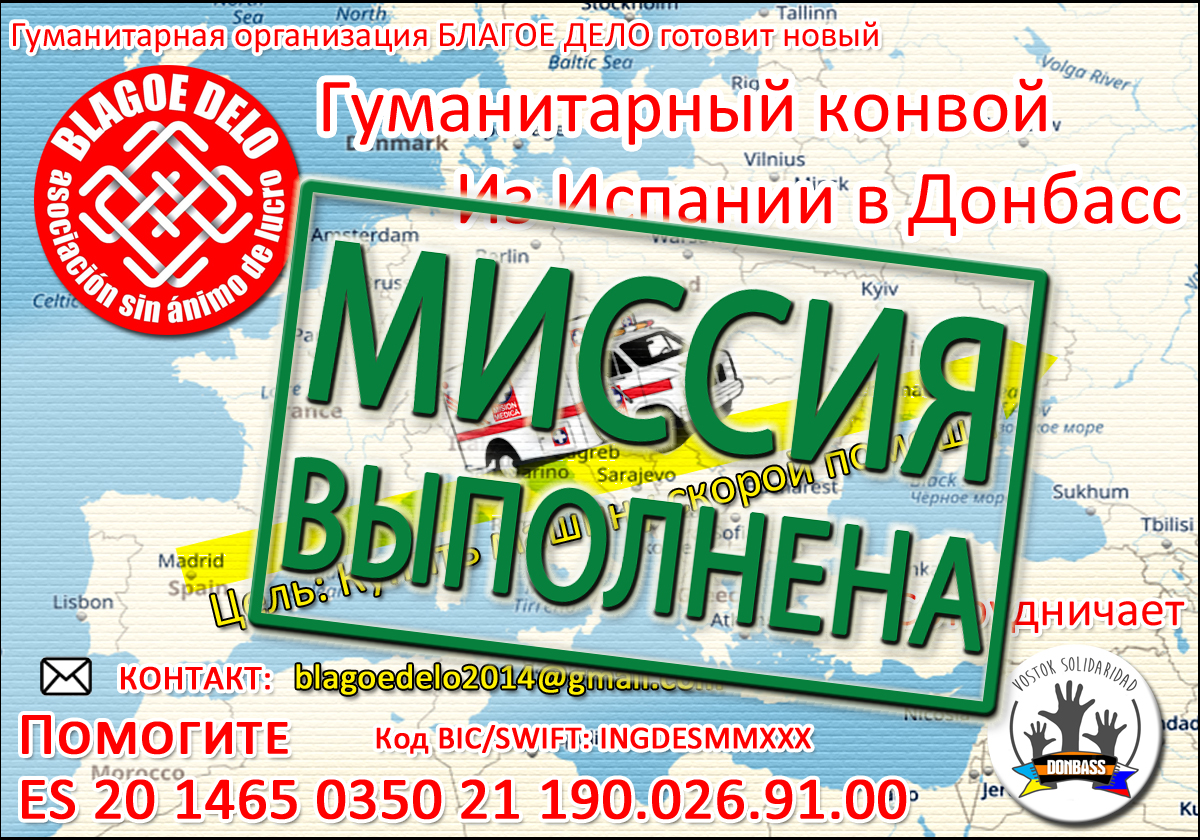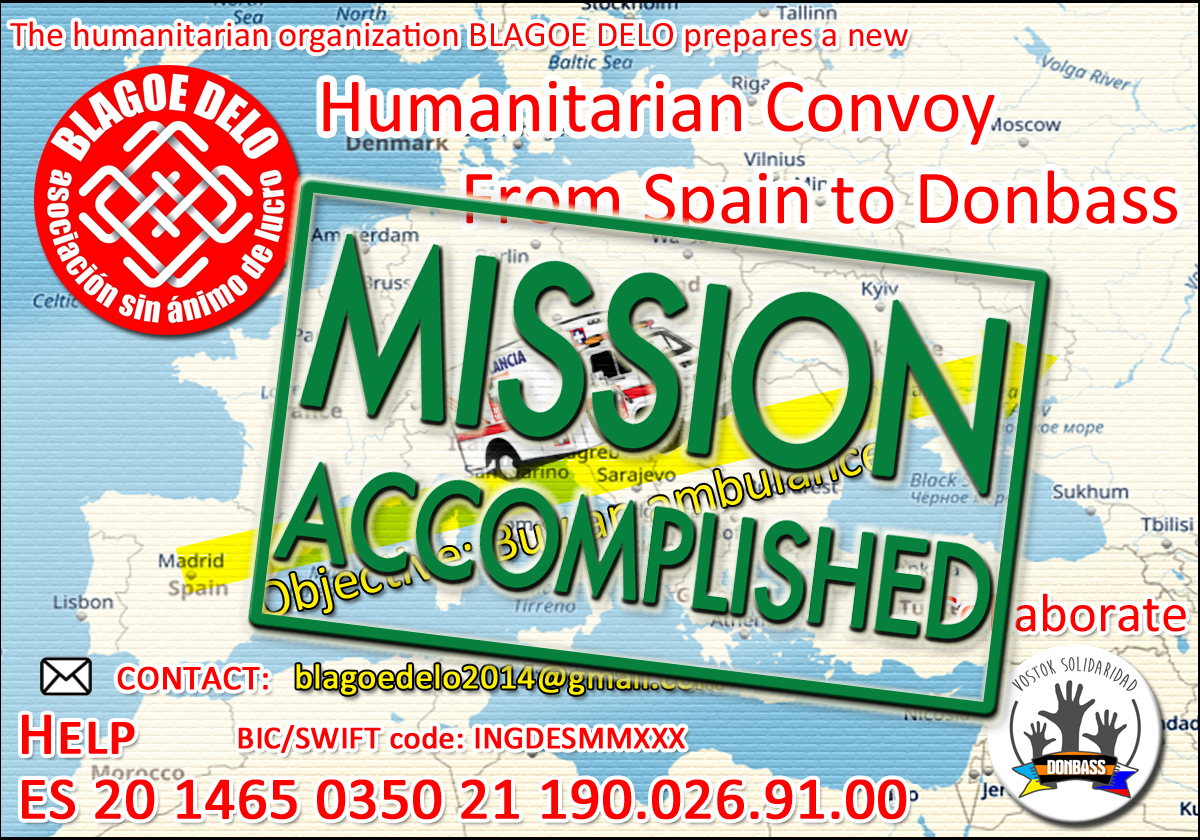Между 9 и 10 мая,
Гуманитарные организации «Восток Солидаридад Донбасс» из Испании и «Оуьест-Эст» из Франции, совместно осуществили гуманитарную
миссию в зону военных действий на Донбассе, в частности, в г. Донецк и
несколько близлежащих поселков и деревень. При прибытии в Донецк, наше первое
впечатление было такое: мы находились в абсолютно нормальном городе, с
открытыми магазинами и многочисленными прохожими на улицах. В общем, обычная
жизнь города, с населением более 1 миллиона человек. Уже отдалившись на
несколько километров от города, картина полностью изменилась- все постройки и
здания были повреждены или разрушены, баррикады и блокгаузы охраняли военные.
Так, как мы очень
спешили и у нас не было ни одной свободной секунды для посещения центра города,
мы решили начать нашу первую миссию от самой линии фронта, от маленького
поселка Зайцево, который прилегает к Горловке и расположен в 50 км к северу от
города Донецка. Там, из-за постоянных артиллерийских атак (а мы слышали очень
частые разрывы снарядов), нас ожидал самый опасный участок, который находится в
нескольких метрах от боевых действий, окруженный предупреждающими знаками о
минах для тех, кто осмелился бы сойти с разминированной и безопасной дороги.
Следует отметить, что как в России так и на Украине- 9 мая не совсем обычный
день. Именно в этот день, эти страны отмечают День Победы- день окончания
Великой Отечественной войны, которая навсегда осталась в памяти русских,
украинцев и многих других народов бывшего Советского Союза. Победа в войне,
которую многие называют Священной и которая принесла 27 миллионов смертей.
Большинство семей бывшего Советского Союза имеют, как минимум, одного погибшего
родственника в этой войне.
Итак, следуя
местной традиции, в день 9 мая мы посетили ветеранов, которые не только
пережили ту давнюю войну, но к сожалению, как и в юности, вновь оказались на
первой линии огня. На самом деле, мы представляли нашу акцию как какую-то
процедуру, так как наши действия состояли всего-лишь из трех частей: дарить
цветы, поздравлять и пожертвовать каждому ветерану по тысячу рублей- просто и
празднично. Но вскоре нам стало ясно, что суровая действительность превзошла
все наши расчеты и прогнозы.
 |
| На снимках вы можете увидеть некоторых ветеранов, которых мы посетили. |
С каждым нашим
посещением того или иного ветерана, нам становилось ясно то тяжелое положение в
котором они пребывают, особенно самые пожилые и одинокие. Иногда мы встречали
ветеранов которых сопровождали несколько родственников. Из-за военных действий
и ввиду множественных повреждений, дома ветеранов находятся без электричества,
воды и газа. Кроме того, ввиду своего возраста, большинство пожилых людей
нуждаются в различных медикаментах: они ограничены в передвижении и страдают
различными заболеваниями. Для этих целей, мы передали тысячу рублей на
медицинские расходы каждому кого посетили. Эта совсем небольшая помощь, но она
необходима потому, что с теми скудными пенсиями которые даже и не всегда
выплачиваются (Украина во всем регионе ввела экономическую блокаду) невозможно
купить лекарства и продукты питания и поэтому в зоне боевых действий пенсионеры
не живут, а выживают.
Каждый ветеран,
которого мы посетили- это наша грустная и счастливая история: грустная из-за
того, что было видно те условия, как и где они жили, а счастливая потому, что
мы видели, как они улыбались и плакали ибо им казалось, совершенно удивительным
то, что в этот день и в этом месте, их навестили из далекой Испании и Франции и
все для того чтобы подарить им цветы и оказать им небольшую финансовую помощь.
И хотя кому-то наш поступок, (который вряд-ли сможет как-то повлиять или
изменить этот страшный военный сценарий) может показаться незначительным или
несущественным, для нас он имеет большое значение и не только для нас, но и для
тех, кого мы посетили. Это не клише и не сентиментальность- наши сердца разбиты
после увиденной нами ужасающей ситуации и, в тоже время, такой искренней
благодарности от стариков за то, что мы сделали.
После окончания
наших поздравлений, мы поехали в школу пос. Зайцево. На самом деле, сегодня это
не школа, а передовая позиция военных ДНР, которые разрешили нам посетить
траншею, каких в этой войне довольно много вырыто по обе стороны фронта. Когда
мы спустились в траншею, нас не покидала мысль, что мы, в этот самый момент
находимся в Европе: и вот- сидим в окопе, на очередной войне, развязанной
одними и теми же лидерами стран США и ЕС, которые всегда говорят о мире и
правах человека, но на самом деле только заботиться о своем бизнесе, и война-
это их самое прибыльное предприятие.
 |
| На этих изображениях можно увидеть советский памятник и школу. На нижнем левом снимке можно увидеть знак, предупреждающий о заминированном поле, а на следующем- въезд в Горловку. |
Окончился наш день
в одном из магазинов Донецка, где мы купили два комплекта ортопедических
ботинок, которые были доставлены двум пожилым людям из Новоазовска.
На следующий день,
10 мая, мы начали гуманитарную акцию в детской кардиологической больнице в г.
Донецке- доставили финансовую помощь в размере 3.000 евро и тем самым,
профинансировали покупку конкретного медицинского материала для проведения трех
сложнейших операций на сердце у троих детей. Кроме того, в больнице мы посетили
объекты и лично смогли убедиться в полном отсутствии большинства медицинских
ресурсов. В нескольких палатах мы видели детей, которых сопровождали
родственники. В зависимости от размера палаты, там может находиться от 2 до 4
детей и один сопровождающий на каждого ребенка. Главврач кардиологического
отделения сказал нам, что больница очень нуждается в адекватных батареях для
дефибрилляторов.
 |
| Вид одной из спален, кухонного оборудования и одного из дефибрилляторов. |
 |
| Дополнительные изображения больничных коридоров, служб и других комнат. |
После посещения
мед.центра и не теряя ни минуты, мы перешли к выполнению второй части нашей
миссии, которая включала в себя поездку к многодетной семье из города Харцизка,
расположенного в 20 км к востоку от Донецка, для доставки этой семье продуктов
питания. Спасаясь от преследований на украинской стороне, эта семья укрывается
в помещениях, преобразованных под жилье, бывшего санатория и предназначенного
для беженцев.
 |
| В образах большая семья и здание, в котором они живут, со стороны. |
Во время нашего
пребывания, мы воспользовались возможностью поговорить с местными жителями об
их жизни. Самые пожилые- те, кто еще помнит пережитую в детстве войну,
несомненно, опечалены и подавленны ситуацией- ужас, пережитый в детстве, вновь
вернулся в их жизнь. Та война и эта чем-то схожи- ведь даже такое сражение, как
за Саур Могилу, вновь повторилось. Эти старики помнят, какое трудное было то
послевоенное время, когда все было разрушено и, чтобы вернуться к нормальной
жизни, нужно было в течение многих лет восстанавливать страну. В тоже время,
для самых молодых, (некоторые из них даже проходили обучение в странах Западной
Европы) очень печально наблюдать то, как Европа обесценила мирную жизнь- ведь
даже молодые европейцы постоянно говорят о войне. Между тем, Донбасс продолжает
жить в условиях войны, с постоянными артобстрелами, которые, в большинстве
своем, происходят в ночное время суток чтобы никто не смог заснуть. Из-за
ночных обстрелов и стараха прямого попадания бомбы в родной дом, люди всегда
спят в подвалах и этот ежедневный кошмар- результат навязанной извне войны,
которая развязанна в интересах правителей США и их «союзников» из ЕС. Цель-
взять под свой контроль всю Украину. Для жителей Донбасса, весь этот ужас
войны- реален и присутсвует ежедневно. Но мы- те кто живет за пределами
Донбасса, в частности и в Западной Европе, сожалеем о том, что здесь, под
мирным небом, мы не ценим ту мирную жизнь о которой так мечтают жители на Донбассе.
Вот так прошла
наша первая гуманитарная поездка на Донбасс- с ограниченными ресурсами, но с
сильной волей чтобы помочь, в силу наших возможностей, там где это необходимо и
единственное в чем мы можем быть уверены, так это в том, что пока эта навязанная
из вне война не окончится, мы снова вернемся с помощью и поможем еще большему
числу нуждающихся людей.






